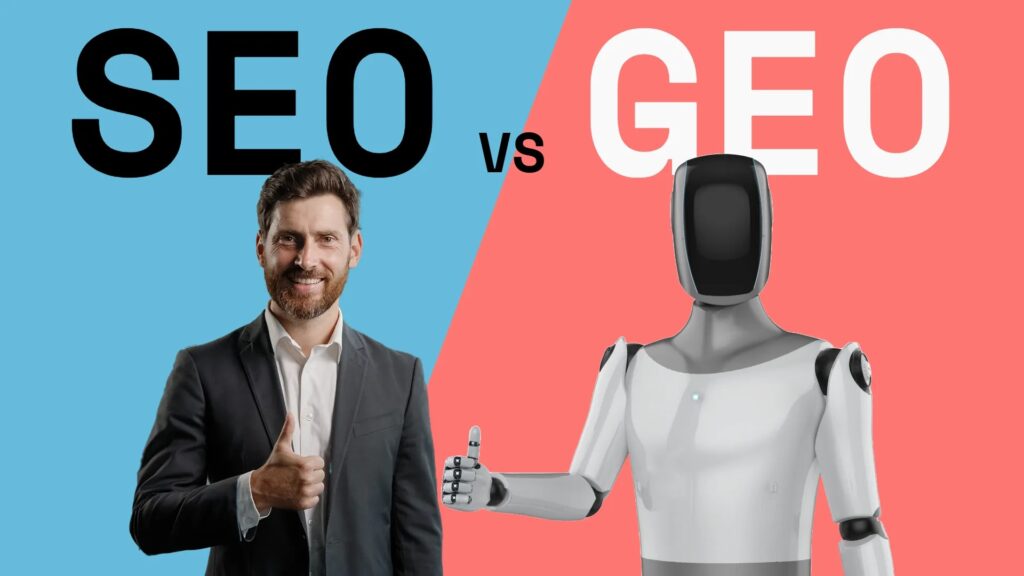What is Generative Engine Optimization (GEO)? The Future of SEO in the Age of AI
- Posted 2 weeks ago
The world of digital marketing is evolving at a rapid pace, and with it, the ways in which search engine optimization (SEO) is being approached. Traditional SEO has long been the cornerstone of online visibility, focusing on optimizing a website’s content, structure, and backlinks to improve rankings on search engines like Google. However, as technology continues to advance, new strategies are emerging to keep up with changing algorithms and user expectations. One such strategy is Generative Engine Optimization (GEO), a concept that leverages the power of artificial intelligence (AI) to transform SEO practices.
In this blog post, we will explore the concept of GEO in-depth, how it differs from traditional SEO, and its potential to revolutionize the way businesses approach online visibility in the age of AI.
What is Generative Engine Optimization (GEO)?
Generative Engine Optimization (GEO) is a cutting-edge approach to SEO that utilizes AI, specifically generative models, to optimize content for search engines. Unlike traditional SEO, which relies heavily on keyword strategies, backlinks, and manual content creation, GEO uses AI-driven tools to generate content that aligns more naturally with user queries and search engine algorithms.
At its core, GEO is about leveraging AI to create high-quality, contextually relevant content that resonates with both search engines and human users. It incorporates generative AI models—such as GPT (Generative Pre-trained Transformer)—to understand search intent, craft unique content, and even predict trends. By doing so, GEO aims to enhance user experience and improve rankings on search engines by staying ahead of algorithm updates and content relevancy.
How Does GEO Work?
Generative Engine Optimization works by integrating AI tools into the SEO workflow. These tools can generate content, provide semantic keyword suggestions, and even help with user experience optimization. The key difference is that, instead of relying on static keyword lists or templates, GEO uses machine learning models to create content that is dynamic and capable of adapting to user needs.
For example, AI-driven tools can analyze vast amounts of data to identify what kind of content resonates best with a target audience. The AI can then generate content that aligns with those patterns, ensuring that it is both informative and optimized for search engines. In addition, generative AI can optimize content in real-time by analyzing current trends and user behavior, enabling it to make adjustments based on emerging needs or search trends.
Furthermore, GEO involves automating the content creation process, reducing the time and effort needed for manual SEO tasks. While traditional SEO requires human input for keyword research, content writing, and optimization, GEO uses AI models to speed up these processes and create more personalized, effective content.
Traditional SEO vs. Generative Engine Optimization (GEO)
While both traditional SEO and GEO aim to improve website rankings, they differ significantly in their approach, strategies, and execution. Below is a comparison between traditional SEO and GEO:

Traditional SEO
Traditional SEO is based on a set of well-established practices that focus on improving a website’s visibility through various optimization techniques. Here are some key elements of traditional SEO:
- Keyword Optimization: Traditional SEO involves thorough keyword research to identify terms that users are likely to search for. These keywords are then strategically placed in website content, headers, meta descriptions, and URLs to improve rankings.
- On-Page Optimization: This includes optimizing title tags, meta descriptions, headers, and images to align with SEO best practices and improve search engine rankings.
- Backlink Building: Building a network of backlinks from reputable sites is a core component of traditional SEO. The more high-quality backlinks a website has, the more authoritative it is considered by search engines.
- Manual Content Creation: Content creation is typically done by SEO experts or content writers who manually craft blog posts, articles, and landing pages based on keyword research and search intent.
- Algorithm Adaptation: Traditional SEO involves staying updated with search engine algorithm changes and adjusting strategies accordingly. This often requires time-consuming manual adjustments.
While traditional SEO has been effective for many years, it has limitations in adapting to the dynamic nature of search engines and user behavior. This is where Generative Engine Optimization comes into play.
Generative Engine Optimization (GEO)
Generative Engine Optimization is a more advanced, AI-driven approach that focuses on creating dynamic and contextually relevant content. Here are the key differences between GEO and traditional SEO:
- AI-Driven Content Creation: Unlike traditional SEO, which relies on manual content creation, GEO uses AI tools to automatically generate high-quality, unique content tailored to search engine algorithms and user intent. This allows for faster content production and more personalized, targeted content.
- Semantic SEO: GEO emphasizes the use of semantic search and natural language processing (NLP) to understand the intent behind user queries. This means that content is created not just with keywords in mind but with the broader context of search intent, improving the chances of ranking for related topics and queries.
- Real-Time Adaptation: GEO models can adjust content in real-time based on emerging trends, user behavior, and algorithm updates. This helps businesses stay ahead of the competition and ensures that their content remains relevant and up-to-date.
- Reduced Human Input: While traditional SEO requires manual input for keyword research, content creation, and optimization, GEO automates many of these processes. This reduces the time and effort needed for SEO tasks and allows businesses to focus on other aspects of their marketing strategy.
- Focus on User Experience: GEO prioritizes user experience by creating content that not only ranks well but also provides valuable information. By using AI to generate content that aligns with search intent, GEO aims to increase user engagement and satisfaction, which can have a direct impact on rankings.
Why GEO is the Future of SEO
As AI technology continues to evolve, GEO is poised to reshape the future of SEO in several key ways:
1. Increased Efficiency and Automation
With AI-powered tools, GEO can automate much of the SEO process, including content generation, keyword analysis, and on-page optimization. This significantly reduces the amount of time and resources needed to implement SEO strategies, allowing businesses to scale their efforts more efficiently.
2. Improved Content Relevance
By utilizing semantic analysis and NLP, GEO creates content that is highly relevant to user intent. This ensures that search engines can better understand and rank content based on its contextual value rather than just keyword matching. As a result, businesses can target broader topics and rank for a wider range of related queries.
3. Real-Time SEO Adjustments
Unlike traditional SEO, which requires manual adjustments to stay ahead of algorithm changes, GEO can adapt content in real-time based on current trends and search behaviors. This flexibility ensures that businesses can quickly respond to shifts in search engine algorithms and user needs, keeping their content fresh and optimized.
4. Enhanced User Experience
GEO places a strong emphasis on user experience by focusing on creating content that meets the needs of users. By prioritizing context, relevance, and readability, GEO ensures that users find the information they are searching for, which can lead to higher engagement and lower bounce rates.
5. Competitive Advantage
As more businesses adopt AI-driven SEO strategies, those who embrace GEO will gain a competitive edge. By staying ahead of the curve in terms of content quality, relevance, and optimization, businesses can improve their rankings and visibility in an increasingly crowded digital landscape.
Conclusion
Generative Engine Optimization (GEO) is the next evolution of SEO, harnessing the power of AI to create content that is more relevant, personalized, and aligned with search intent. Unlike traditional SEO, which relies on manual processes and static strategies, GEO automates many aspects of SEO, allowing businesses to stay ahead of algorithm updates and emerging trends.
As AI technology continues to evolve, GEO will play an increasingly important role in shaping the future of SEO. By focusing on content relevance, user experience, and real-time adaptation, GEO offers businesses the tools they need to thrive in the ever-changing digital landscape. Whether you’re a small business or a large enterprise, embracing GEO could be the key to staying competitive in the age of AI-driven marketing.
Also Explore : LLMs.txt Explained: A Must-Have for SEOs in the Age of Generative AI

